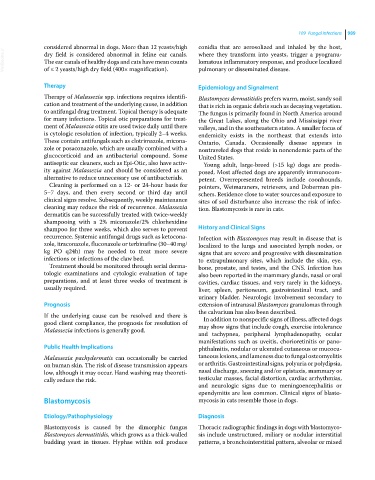Page 1051 - Clinical Small Animal Internal Medicine
P. 1051
109 Fungal Infections 989
considered abnormal in dogs. More than 12 yeasts/high conidia that are aerosolized and inhaled by the host,
VetBooks.ir dry field is considered abnormal in feline ear canals. where they transform into yeasts, trigger a pyogranu
lomatous inflammatory response, and produce localized
The ear canals of healthy dogs and cats have mean counts
pulmonary or disseminated disease.
of ≤ 2 yeasts/high dry field (400× magnification).
Therapy Epidemiology and Signalment
Therapy of Malassezia spp. infections requires identifi Blastomyces dermatitidis prefers warm, moist, sandy soil
cation and treatment of the underlying cause, in addition that is rich in organic debris such as decaying vegetation.
to antifungal drug treatment. Topical therapy is adequate The fungus is primarily found in North America around
for many infections. Topical otic preparations for treat the Great Lakes, along the Ohio and Mississippi river
ment of Malassezia otitis are used twice daily until there valleys, and in the southeastern states. A smaller focus of
is cytologic resolution of infection, typically 2–4 weeks. endemicity exists in the northeast that extends into
These contain antifungals such as clotrimazole, micona Ontario, Canada. Occasionally disease appears in
zole or posaconazole, which are usually combined with a nontraveled dogs that reside in nonendemic parts of the
glucocorticoid and an antibacterial compound. Some United States.
antiseptic ear cleaners, such as Epi‐Otic, also have activ Young adult, large‐breed (>15 kg) dogs are predis
ity against Malassezia and should be considered as an posed. Most affected dogs are apparently immunocom
alternative to reduce unnecessary use of antibacterials. petent. Overrepresented breeds include coonhounds,
Cleaning is performed on a 12‐ or 24‐hour basis for pointers, Weimaraners, retrievers, and Doberman pin
5–7 days, and then every second or third day until schers. Residence close to water sources and exposure to
clinical signs resolve. Subsequently, weekly maintenance sites of soil disturbance also increase the risk of infec
cleaning may reduce the risk of recurrence. Malassezia tion. Blastomycosis is rare in cats.
dermatitis can be successfully treated with twice‐weekly
shampooing with a 2% miconazole/2% chlorhexidine
shampoo for three weeks, which also serves to prevent History and Clinical Signs
recurrence. Systemic antifungal drugs such as ketocona Infection with Blastomyces may result in disease that is
zole, itraconazole, fluconazole or terbinafine (30–40 mg/ localized to the lungs and associated lymph nodes, or
kg PO q24h) may be needed to treat more severe signs that are severe and progressive with dissemination
infections or infections of the claw bed. to extrapulmonary sites, which include the skin, eye,
Treatment should be monitored through serial derma bone, prostate, and testes, and the CNS. Infection has
tologic examinations and cytologic evaluation of tape also been reported in the mammary glands, nasal or oral
preparations, and at least three weeks of treatment is cavities, cardiac tissues, and very rarely in the kidneys,
usually required. liver, spleen, peritoneum, gastrointestinal tract, and
urinary bladder. Neurologic involvement secondary to
Prognosis extension of intranasal Blastomyces granulomas through
the calvarium has also been described.
If the underlying cause can be resolved and there is In addition to nonspecific signs of illness, affected dogs
good client compliance, the prognosis for resolution of may show signs that include cough, exercise intolerance
Malassezia infections is generally good.
and tachypnea, peripheral lymphadenopathy, ocular
manifestations such as uveitis, chorioretinitis or pano
Public Health Implications phthalmitis, nodular or ulcerated cutaneous or mucocu
Malassezia pachydermatis can occasionally be carried taneous lesions, and lameness due to fungal osteomyelitis
on human skin. The risk of disease transmission appears or arthritis. Gastrointestinal signs, polyuria or polydipsia,
low, although it may occur. Hand washing may theoreti nasal discharge, sneezing and/or epistaxis, mammary or
cally reduce the risk. testicular masses, facial distortion, cardiac arrhythmias,
and neurologic signs due to meningoencephalitis or
ependymitis are less common. Clinical signs of blasto
Blastomycosis mycosis in cats resemble those in dogs.
Etiology/Pathophysiology Diagnosis
Blastomycosis is caused by the dimorphic fungus Thoracic radiographic findings in dogs with blastomyco
Blastomyces dermatitidis, which grows as a thick‐walled sis include unstructured, miliary or nodular interstitial
budding yeast in tissues. Hyphae within soil produce patterns, a bronchointerstitial pattern, alveolar or mixed

